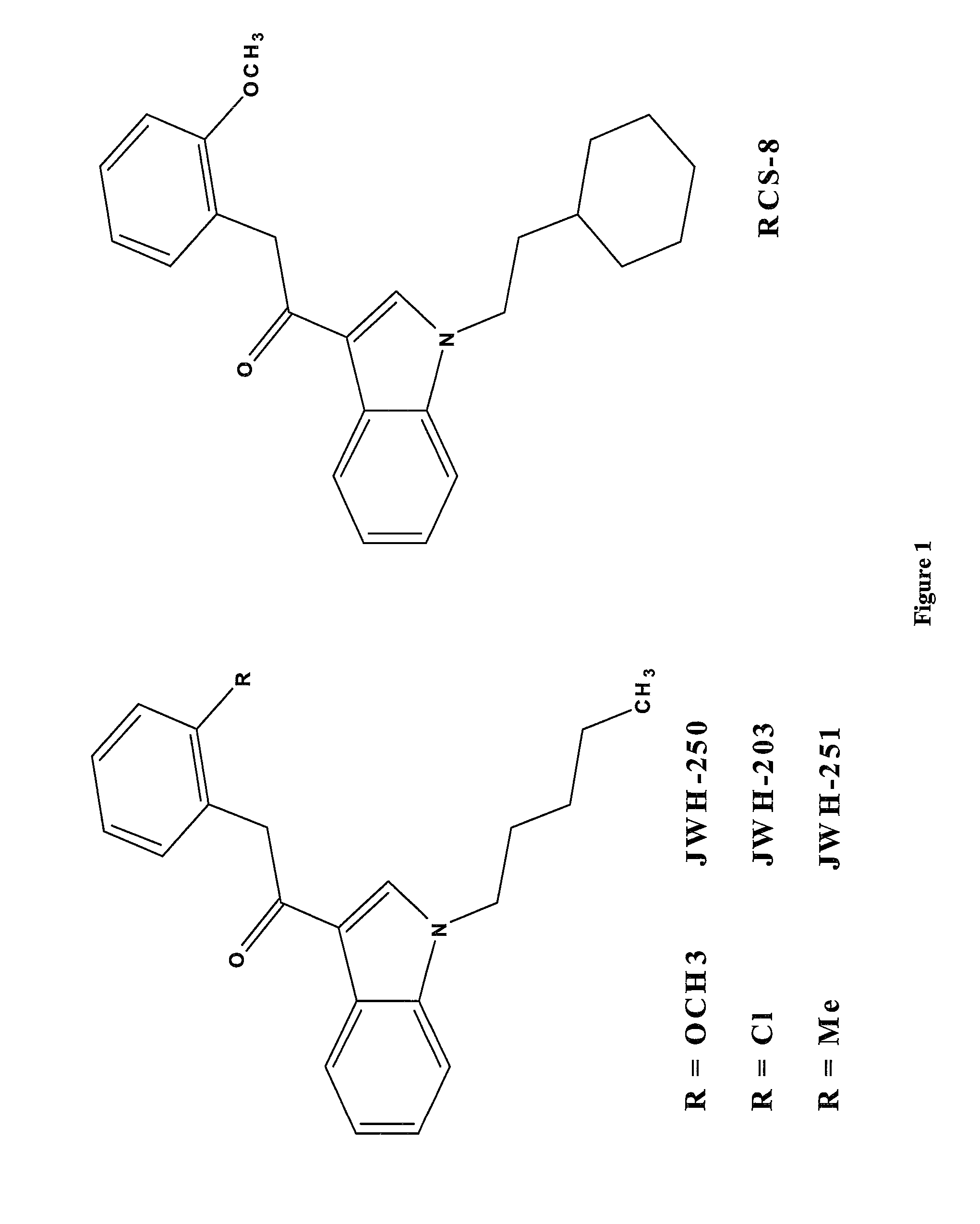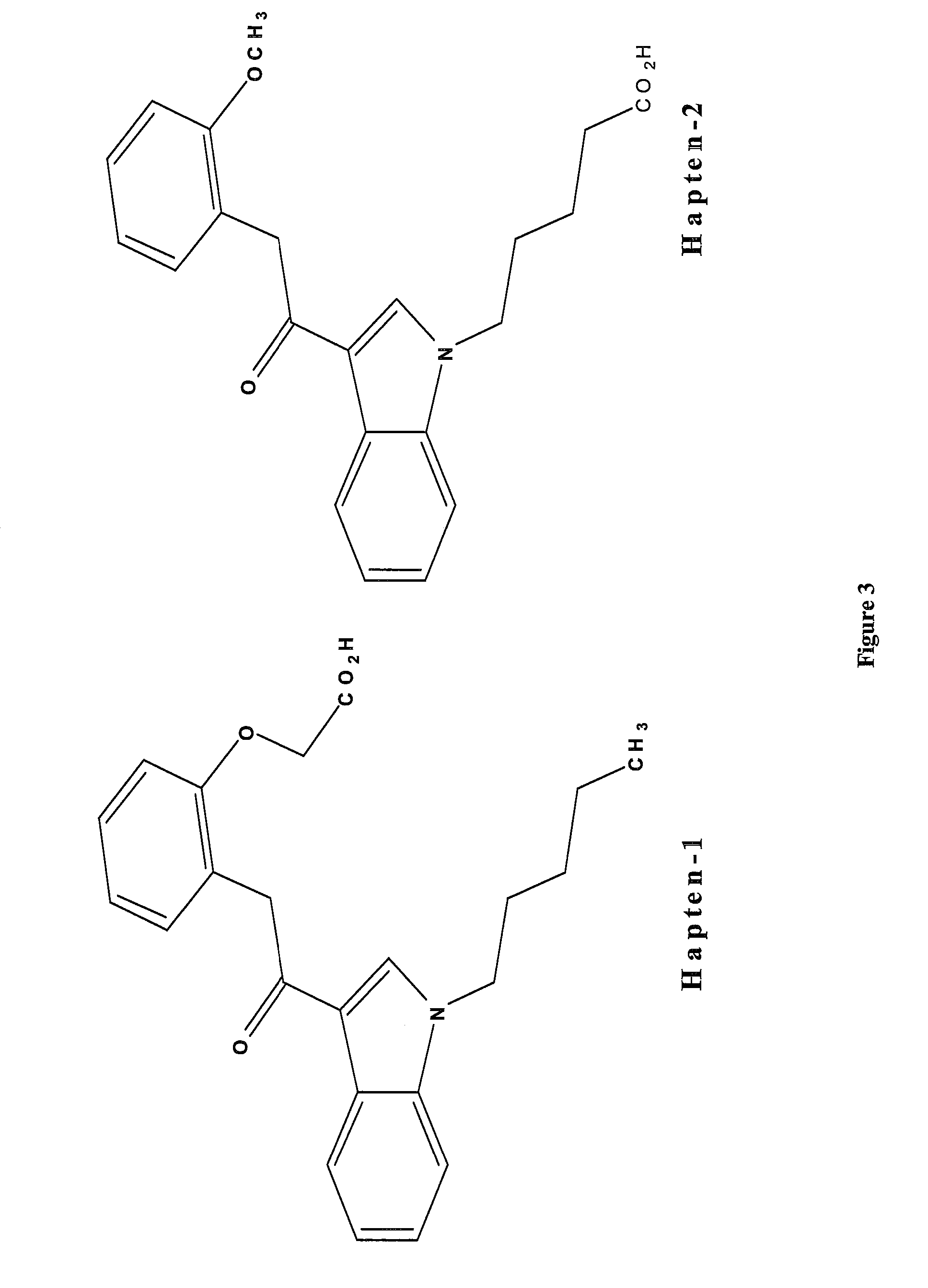Detection of synthetic cannabinoids
a synthetic cannabinoid and detection technology, applied in the field of detection of synthetic cannabinoid, can solve the problems of insufficient detection method, insufficient characterisation, and further resource intensive and costly chemical analytical study
- Summary
- Abstract
- Description
- Claims
- Application Information
AI Technical Summary
Benefits of technology
Problems solved by technology
Method used
Image
Examples
example 1
Preparation of 2-methoxybenzoyl chloride 2
[0048]2-Methoxyphenylacetic acid 1 (16.6 g, 0.1 mol) was dissolved in thionyl chloride (100 ml) and refluxed for 90 min, and then the solvent was removed under vacuo and azeotroped twice with benzene (2×100 ml) to give 18.46 g (100%) of 2-methoxybenzoyl chloride 2 as a dark oil.
example 2
Preparation of 1-(1H-indol-3-yl)-2-(2-methoxyphenyl)ethanone 3
[0049]Indole (11.7 g, 100 mmol) was dissolved in diethylether (100 ml) under nitrogen atmosphere and cooled to 0° C. 3M MeMgBr solution (35 ml, 105 mmol) was added dropwise and allowed to stir at room temperature for 2 hours. The reaction mixture was cooled at 0° C. and a solution of 2-methoxybenzoyl chloride 2 (18.46 g, 100 mmol) in diethyl ether (100 ml) was added dropwise with vigorous stirring. The reaction mixture was then allowed to stir at room temperature for 2 hours. A solution of ammonium chloride (300 ml) was added to the reaction mixture and the resulting mixture was stirred at room temperature overnight. The solid that was formed was collected by filtration, washed with water and hexane then dried in a dessicator over phosphorous pentoxide to give 13 g (49%) of 1-(1H-indol-3-yl)-2-(2-methoxyphenyl)ethanone 3 as a cream solid.
example 3
Preparation of 2-(2-methoxyphenyl)-1-(1-pentyl-1H-indol-3-yl)ethanone (JWH-250) 4
[0050]60% Sodium hydride in mineral oil (1.8 g, 45.23 mmol) was suspended in dimethylformamide (100 ml) and 1-(1H-indol-3-yl)-2-(2-methoxyphenyl)ethanone 3 (10 g, 37.70 mmol) was added portionwise at room temperature, allowing to stir further 45 min at room temperature after the addition was finished. 1-Bromopentane (7.02 ml, 56.55 mmol) was added dropwise at room temperature and the reaction mixture was stirred at room temperature overnight. Water (200 ml) was added and the mixture was extracted three times with ethyl acetate (3×200 ml). The organic fractions were combined, washed with water (200 ml) and brine (200 ml) and dried over sodium sulphate and concentrated in vacuo. The residue was purified by column chromatography (Biotage Isolera 4, SNAP-100 g, 5%-20% ethyl acetate hexane containing 5% dichloromethane) to give 6.2 g (41%) of 2-(2-methoxyphenyl)-1-(1-pentyl-1H-indol-3-yl)ethanone (JWH-250) 4...
PUM
| Property | Measurement | Unit |
|---|---|---|
| concentration | aaaaa | aaaaa |
| concentration | aaaaa | aaaaa |
| temperature | aaaaa | aaaaa |
Abstract
Description
Claims
Application Information
 Login to View More
Login to View More - R&D
- Intellectual Property
- Life Sciences
- Materials
- Tech Scout
- Unparalleled Data Quality
- Higher Quality Content
- 60% Fewer Hallucinations
Browse by: Latest US Patents, China's latest patents, Technical Efficacy Thesaurus, Application Domain, Technology Topic, Popular Technical Reports.
© 2025 PatSnap. All rights reserved.Legal|Privacy policy|Modern Slavery Act Transparency Statement|Sitemap|About US| Contact US: help@patsnap.com



